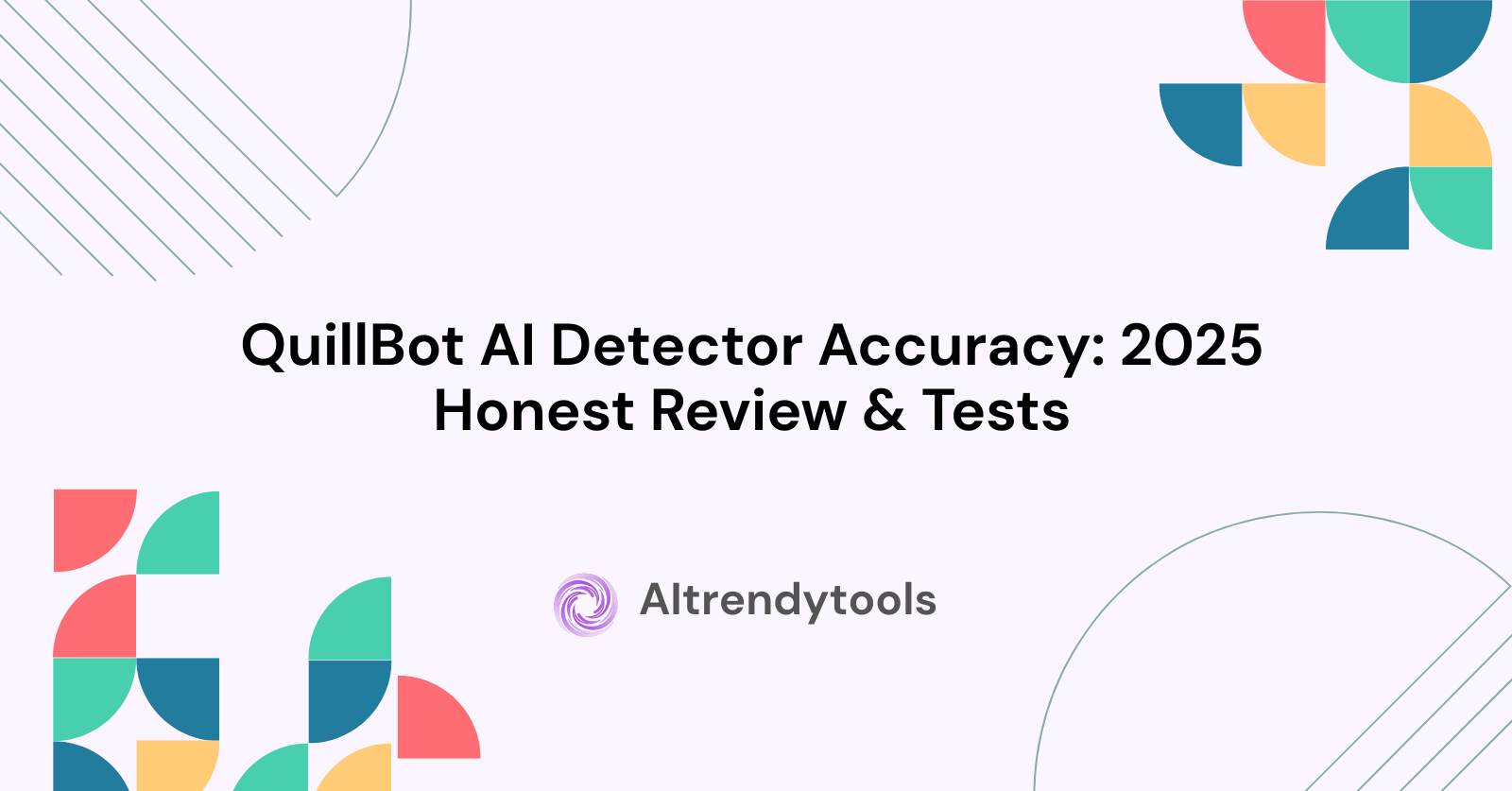🔥 AITrendytools: The Fastest-Growing AI Platform |
Write for usQuillBot AI Detector Accuracy: 2025 Honest Review & Tests
Is QuillBot's AI detector accurate? We tested it against competitors. Learn its 80% accuracy rate, false positive issues, and better alternatives.
Dec 8, 2025
If you're a student, educator, or content creator trying to verify whether text is AI-generated, you've probably stumbled upon QuillBot's AI detector. But here's the question everyone's asking: Is it actually accurate?
After analyzing independent tests, user reports, and comparing it against leading competitors, I'm going to give you the straight answer—along with what you need to know before relying on it for important decisions.
The Bottom Line: QuillBot's Accuracy Is About 80%
Based on independent evaluations, QuillBot's AI detector achieves approximately 80% accuracy. While this sounds decent on paper, it means 1 in 5 detections could be wrong—which is significant if you're using it for academic integrity checks or content verification.
To put this in perspective, competitors like GPTZero and Scribbr consistently outperform QuillBot in accuracy tests. If you're looking for more reliable options, you might want to explore other AI content detection tools that offer higher accuracy rates. Independent journalism evaluations by ZDNet and other tech publications confirm these findings.
What QuillBot Gets Right
Before diving into the limitations, let's acknowledge where QuillBot's detector actually delivers value:
Multi-Language Support
Unlike many competitors that only work with English, QuillBot supports four languages: English, Spanish, German, and French. If you're working with multilingual content, this gives it a legitimate edge.
Sentence-Level Analysis
Rather than just flagging entire documents, QuillBot provides granular, sentence-by-sentence feedback. This helps you identify specific sections that might be AI-generated, which is more actionable than a simple percentage score.
User-Friendly Interface
The tool is straightforward to use—paste your text, click analyze, and get results within seconds. The reports are detailed and easy to interpret, even for non-technical users.
The Serious Accuracy Problems You Should Know About
Here's where things get concerning, especially if you're relying on this for high-stakes decisions:
1. False Positives Are Common
QuillBot has a documented tendency to falsely flag human-written content as AI-generated. This is particularly problematic for:
- Creative writing with unique voice or style
- Informal, conversational content
- Technical writing with specific terminology
Imagine submitting your carefully written essay only to have it wrongly flagged as AI. This has happened to real users based on Reddit discussions and user testimonials. If you're concerned about false positives, consider using ZeroGPT Plus as a second opinion—it's free and doesn't require login.
2. Inconsistent Results Across Text Types
Independent testing reveals that QuillBot's performance varies wildly depending on:
- Text length (requires minimum 80 words)
- Writing complexity
- Content type (struggles with mixed human-AI content)
- Writing style (formal vs. casual)
The same piece of text can sometimes produce different results when analyzed at different times, which raises questions about reliability.
3. Struggles With Hybrid Content
In real-world scenarios, many people use AI to draft content and then heavily edit it. QuillBot's detector has difficulty identifying this mixed human-AI content, often giving unreliable scores that don't reflect the actual composition process. For those who want to humanize AI-generated text to avoid detection, tools like HIX Bypass have emerged as alternatives.
How QuillBot Compares to Top Competitors
Based on independent testing and user experiences, here's how QuillBot stacks up:
GPTZero: Higher overall accuracy (estimated 85-90%), better at detecting sophisticated AI writing, more reliable for academic use
Scribbr: Strong accuracy with fewer false positives, particularly good for academic papers
Originality.ai: Claims 96% accuracy in detecting paraphrased AI content (including text processed through QuillBot's paraphraser)
Grammarly's AI Detector: Approximately 87% accuracy based on independent tests, with better handling of mixed content
For a comprehensive comparison of AI detection tools, check out our guide to Polygraf AI Content Detector, which includes plagiarism checking alongside AI detection.
Real-World Testing: What Actually Happens
When tech journalists tested QuillBot alongside other detectors using the same AI-generated essays:
- Turnitin, Originality, and QuillBot all flagged a ChatGPT essay as 100% AI-written (good performance in this case)
- However, when tested on human-written creative content, QuillBot produced more false positives than GPTZero
- With edited AI content (AI draft + human revisions), QuillBot's accuracy dropped significantly
Who Should (and Shouldn't) Use QuillBot's AI Detector
Good Use Cases:
- Quick preliminary checks for content review
- Multi-language content verification where few alternatives exist
- Learning purposes to understand how AI detectors work
- Low-stakes situations where false positives won't cause serious consequences
Situations to Avoid:
- Academic integrity decisions (universities should use more accurate tools like Turnitin or GPTZero)
- Professional content verification requiring high confidence
- High-stakes assessments where false accusations could harm someone
- As the sole verification method for important decisions
The Technology Behind QuillBot's Detection
QuillBot's AI detector analyzes text patterns to estimate likelihood of AI generation rather than flagging individual words. It looks at:
- Sentence structure patterns
- Word choice consistency
- Stylistic markers common in AI writing
- Predictability of language flow
However, the underlying model appears less sophisticated than competitors', which may explain the accuracy gap. For those interested in how AI detection works at a technical level, Decopy AI offers similar pattern-recognition technology with transparent methodology.
My Recommendation: Use It as Part of a Toolkit, Not the Whole Solution
If you're serious about AI detection, don't rely on QuillBot alone. Instead:
- Use multiple detectors: Run text through QuillBot, GPTZero, and at least one other tool
- Compare results: Look for consensus across tools rather than trusting one score
- Consider context: Factor in the writer's known style, previous work, and circumstances
- Review manually: No AI detector is perfect—human judgment remains essential
- Focus on learning, not just policing: If you're an educator, use detection as a starting point for conversation
Final Verdict
Is QuillBot's AI detector accurate enough? For casual use and preliminary screening, yes. For high-stakes decisions, academic integrity, or professional verification, no.
With 80% accuracy and known false positive issues, QuillBot serves best as a supplementary tool rather than your primary AI detection solution. The multi-language support and user-friendly interface are genuine advantages, but the accuracy gap compared to GPTZero and Scribbr is significant enough that you should consider alternatives for important use cases.
For most users, I recommend trying GPTZero for academic content or Originality.ai for professional content creation, while keeping QuillBot in your toolkit for quick checks or multilingual text.
If you're exploring AI tools for various purposes beyond just detection, browse our comprehensive AI tools directory to find solutions that match your specific needs.
🚀 Submit Your Tool to Our Comprehensive AI Tools Directory
Get your AI tool featured on our complete directory at AITrendytools and reach thousands of potential users. Select the plan that best fits your needs.





Join 30,000+ Co-Founders
Related Blogs
Neural Blender: 7 Ways This Free AI Art Tool Transforms Ideas Into Masterpieces
Discover Neural Blender, the free AI art generator transforming text into stunning images. Learn features, tips, and comparisons to create breathtaking art today.
Bai Chat: 7 Features That Make It Worth Trying in 2025
Discover what is Bai chat, explore Bai chat features, learn how to use Bai chat effectively, and access the Bai chat free download. Complete 2025 guide.
Elevate Your Marketing with Advanced Image Generation
Discover how AI image generation transforms marketing with faster, cost-effective, high-quality visuals that elevate campaigns and boost engagement.
Submit Your Tool to Our Comprehensive AI Tools Directory
List your AI tool on AItrendytools and reach a growing audience of AI users and founders. Boost visibility and showcase your innovation in a curated directory of 30,000+ AI apps.





Join 30,000+ Co-Founders

